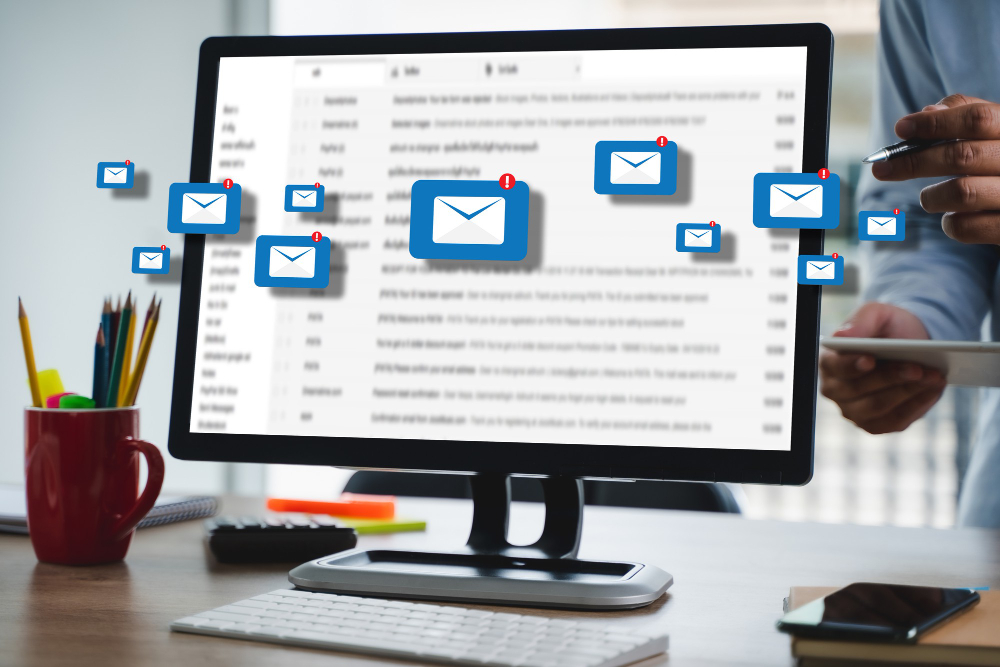Email marketing is part of digital marketing statistics which involves sending promotional messages or commercial advertisements to a group of people via email.
It is a cost-effective and efficient way for businesses to connect with their target audience and nurture relationships with potential and existing customers.
In this article, we will discuss the basics of email marketing, its benefits, best practices, and tools.
The Basics Of Email Marketing

Email marketing involves sending commercial messages, typically this is a group of people, using email. These messages could be promotional, informative, or both, depending on the goal of the campaign.
The primary objective of email marketing is to promote a product or service, generate leads, and drive sales.
Email marketing can be used for various purposes, such as:
- Promoting new products or services
- Increasing brand awareness
- Announcing special offers or discounts
- Sharing educational content or news updates
- Building relationships with customers
- The process of email marketing is the step of building an email list, creating a campaign, and sending it to the target audience.
- The email list consists of subscribers who have opted in to receive emails from the business. These subscribers can be obtained through various methods, such as website signups, social media, or in-person events.
Once the email list is built, the next step is to create a campaign. The campaign consists of an email message, a subject line, and any images or attachments. The email message should be crafted in a way that aligns with the business’s goals and resonates with the target audience.
The final step is to send the campaign to the email list. Email marketing platforms like Mailchimp, Constant Contact, and Sendinblue provide tools to manage email lists, create campaigns, and track results. These platforms also offer analytics to measure the success of a campaign and optimize future campaigns.
Benefits Of Email Marketing
Email marketing offers several benefits to businesses, such as:
1. Cost-Effective
Email marketing is an affordable way to reach a large audience. It requires very minimal resources and has a high ROI.
2. Targeted
Email marketing allows businesses to target specific groups of people based on demographics, interests, and behavior.
3. Personalized
Email marketing can be personalized based on the recipient’s preferences and behavior. This makes the email more relevant and engaging.
4. Measurable
Email marketing provides analytics that allows businesses to measure the success of their campaigns and optimize future campaigns.
5. Build Relationships
Email marketing can be used to build relationships with potential and existing customers. It allows businesses to stay top of mind and provide value to their audience.
Best Practices For Email Marketing
To get the most out of email marketing, businesses should follow best practices, such as:
Build a quality email list: A quality email list consists of multiple subscribers who are opted in to receive emails from other businesses. Businesses should avoid purchasing email lists or adding people without their consent.
Use a clear and compelling subject line: The subject line is the first thing that recipients see, so it should be clear, concise, and compelling. It should also align with the email message.
1. Personalize the email
Personalization can be as simple as addressing the recipient by name. It can also involve segmenting the email list and sending personalized content based on the recipient’s interests and behavior.
2. Create engaging content
The email marketing message should be engaging and relevant to the recipient. It should align with the business’s goals and provide value to the audience.
3. Use a clear Call-to-action
The email should have a clear call-to-action that aligns with the business’s goals. It could be a link to a product page, a sign-up form, or a survey.
Test and optimize: A/B testing can be used to test different elements of the email.
4. Optimize for mobile devices
More than half of all emails are opened on mobile devices, so it’s important to ensure that the email is optimized for mobile. These include using a mobile-responsive design, then using a very clear and legible font, while using a single-column layout.
5. Keep the email design simple
The design of the email should be simple and simple to read. It should have a clear hierarchy, with the most important information at the top.
6. Avoid spam filters
Email spam filters can flag emails as spam if they contain certain keywords or phrases. Businesses should avoid using these words or phrases, such as “free,” “discount,” or “buy now.”
7. Send emails at the right time
The timing of email marketing can affect its open and click-through rates. Businesses should consider the time zone of their audience and send emails at a time when they are most likely to check their inbox.
8. Use a consistent sender name and email address
The sender’s name and email address should be consistent across all emails. This helps to build trust and familiarity with the audience.
9. Segment the email list
Segmenting the email list allows businesses to send targeted and personalized content to specific groups of people. This can increase engagement and conversion rates.
10. Keep the email frequency consistent
Businesses should keep the frequency of their emails consistent. This helps to build a relationship with the audience and avoid overwhelming them with too many emails.
11. Provide an easy way to unsubscribe
It’s important to provide an easy way for subscribers to unsubscribe from the email list. This helps to maintain a positive reputation and avoid being flagged as spam.
Email Marketing Tools
There are several email marketing tools available to businesses, such as:
1. Mailchimp
Mailchimp is a popular email marketing tool that allows businesses to create and send email campaigns, build email lists, and track results.
2. Constant Contact
Constant Contact is an email marketing tool that provides a suite of tools for businesses, including email marketing, social media marketing, and online listing management.
3. Sendinblue
Sendinblue is an email marketing tool that provides a range of features, such as email marketing, SMS marketing, and marketing automation.
4. Hubspot
Hubspot provides a range of marketing tools, including email marketing, social media marketing, and marketing automation.
5. Aweber
Aweber is an email marketing tool that provides features such as email automation, email templates, and autoresponders.
Conclusion
Email marketing is a much more affordable and efficient way for businesses to connect with their target audience and nurture relationships with potential and existing customers.
To get the most out of email marketing, businesses should follow best practices, such as building a quality email list, creating engaging content, and optimizing for mobile devices. There are several email marketing tools available to businesses, each with its own features and benefits.
By following best practices and also using the right tools, businesses can create effective email marketing campaigns that drive results.




